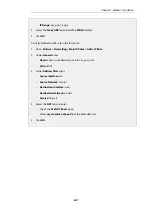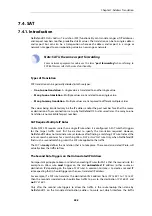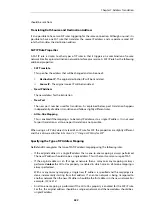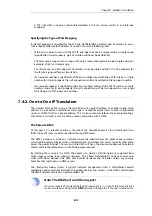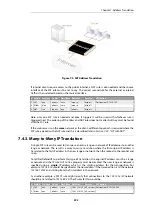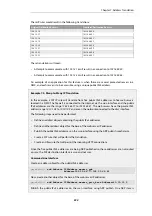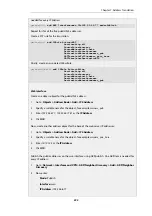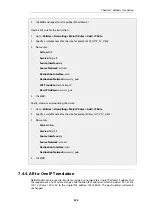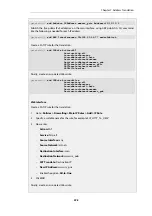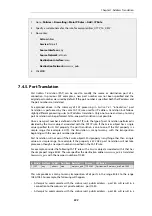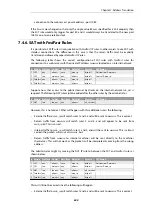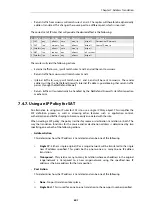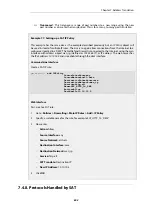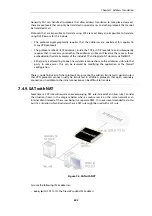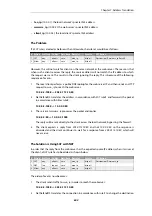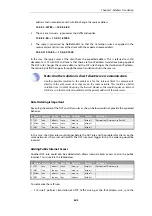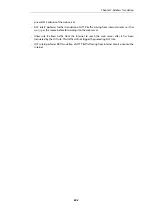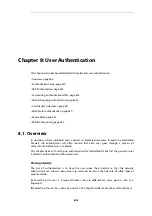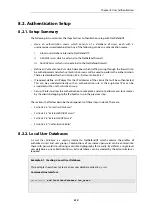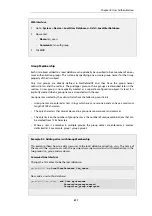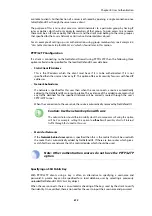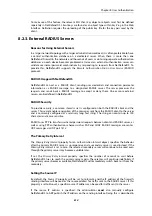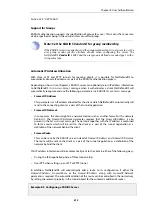
•
Return traffic from
wwwsrv
will match rules 2 and 3. The replies will therefore be dynamically
address translated. This changes the source port to a different port, which is incorrect.
The correct set of IP rules that will provide the desired effect is the following:
# Action
Src Iface
Src Net
Dest Iface Dest Net
Service
SAT Action
1 SAT
any
all-nets
core
wan_ip
http-all
Destination IP: wwwsrv
2 SAT
lan
wwwsrv
any
all-nets
http-all
Source IP: wan_ip
3 FwdFast any
all-nets
core
wan_ip
http-all
4 NAT
lan
lan_net
any
all-nets
all_services
5 FwdFast lan
wwwsrv
any
all-nets
http-all
These rules will yield the following actions:
•
External traffic to
wan_ip
will match rules 1 and 5 and will be sent to
wwwsrv
.
•
Return traffic from
wwwsrv
will match rules 2 and 3.
•
Internal traffic to
wan_ip
will match rules 1 and 4, and will be sent to
wwwsrv
. The sender
address will be the NetDefend Firewall's internal IP address, guaranteeing that return traffic
passes through the NetDefend Firewall.
•
Return traffic will automatically be handled by the NetDefend Firewall's stateful inspection
mechanism.
7.4.7. Using an IP Policy for SAT
An alternative to using two IP rules for SAT is to use a single
IP Policy
object. This simplifies the
SAT definition process as well as allowing other features such as application control,
authentication and traffic shaping to be more easily associated with the rule.
When creating a SAT policy, the policy is either for source or destination translation, or both. The
way the translation functions for the source and/or destination address is determined by two
specifying one or both of the following actions:
•
Address Action
This determines how the IP address is translated and can be one of the following:
i.
Single IP - Either a single original IP or a range/network will be translated to the single
new IP address specified. This yields both a one-to-one or a many-to-one IP address
translation.
ii.
Transposed - This yields a many-to-many translation where each address in the original
range/network is transposed to a new range/network, using the specified new IP
address as the base address for the transposition.
•
Port Action
This determines how the IP address is translated and can be one of the following:
i.
None - No port translation takes place.
ii.
Single Port - This is used for a one-to-one translation to the new port number specified.
Chapter 7: Address Translation
601
Summary of Contents for NetDefendOS
Page 30: ...Figure 1 3 Packet Flow Schematic Part III Chapter 1 NetDefendOS Overview 30 ...
Page 32: ...Chapter 1 NetDefendOS Overview 32 ...
Page 144: ...Chapter 2 Management and Maintenance 144 ...
Page 284: ...Chapter 3 Fundamentals 284 ...
Page 392: ...Chapter 4 Routing 392 ...
Page 419: ... Host 2001 DB8 1 MAC 00 90 12 13 14 15 5 Click OK Chapter 5 DHCP Services 419 ...
Page 420: ...Chapter 5 DHCP Services 420 ...
Page 573: ...Chapter 6 Security Mechanisms 573 ...
Page 607: ...Chapter 7 Address Translation 607 ...
Page 666: ...Chapter 8 User Authentication 666 ...
Page 775: ...Chapter 9 VPN 775 ...
Page 819: ...Chapter 10 Traffic Management 819 ...
Page 842: ...Chapter 11 High Availability 842 ...
Page 866: ...Default Enabled Chapter 13 Advanced Settings 866 ...
Page 879: ...Chapter 13 Advanced Settings 879 ...

